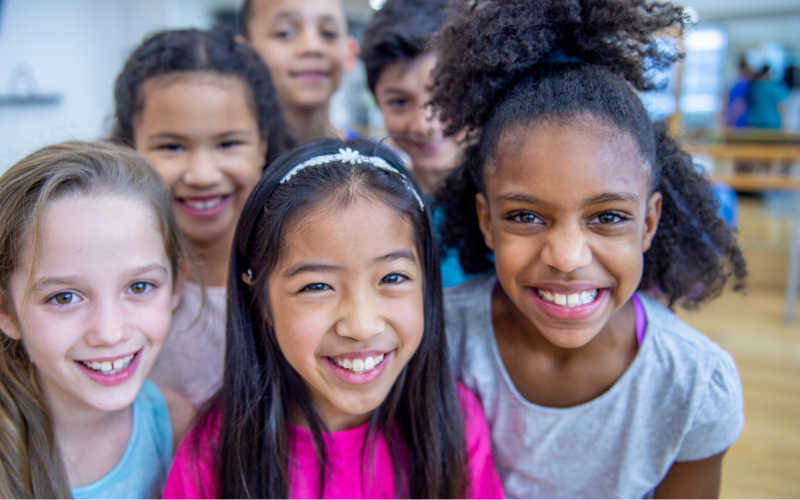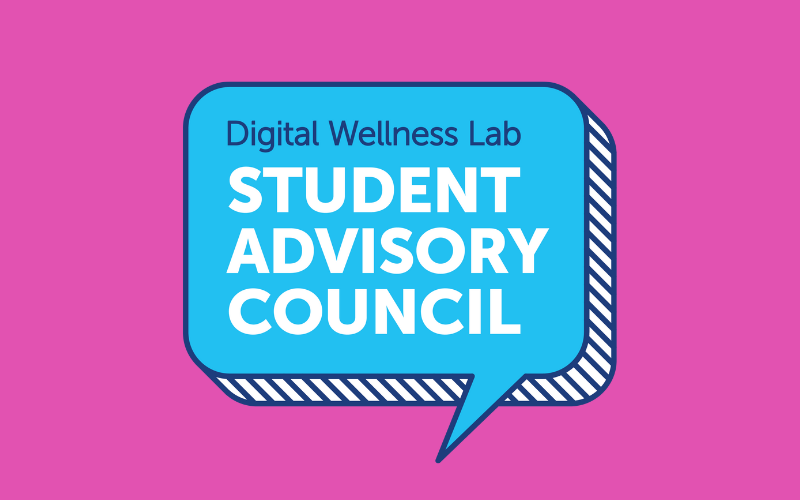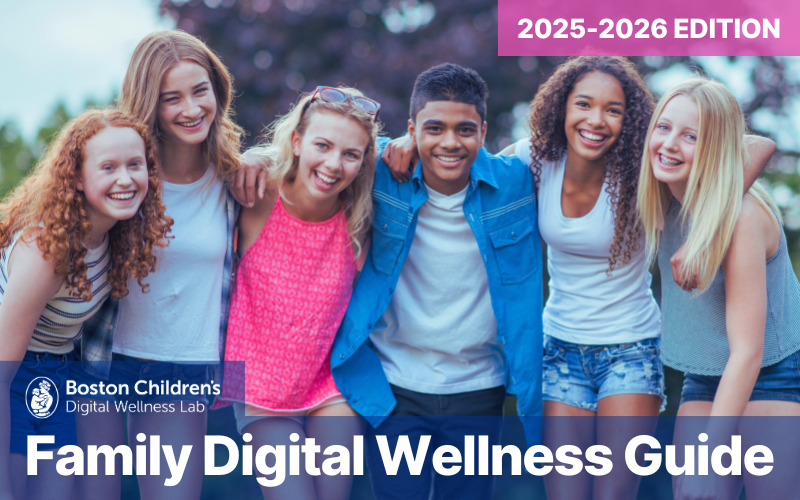Family Digital Wellness Guide
Grade School to Tween (Ages 6-12)
Guide Exploration with Balance and Safety in Mind

As children enter middle childhood, their curiosity grows, and their world begins to expand beyond home and family. During this stage, technology often becomes a bigger part of their lives, from educational tools at school to games, apps, and social interactions at home. This increased exposure presents an excellent opportunity to help children develop responsible and intentional habits with technology. Setting clear family guidelines, such as agreed-upon screen time limits or device-free zones, can provide structure while encouraging balance between digital and offline activities.
This is also a time when children start to build independence, so actively involving them in discussions about technology use is key. For example, you might explore educational apps or games together, empowering them to make productive choices while still feeling supported. At the same time, open communication about online safety becomes increasingly important. Teaching kids how to recognize inappropriate content, avoid oversharing personal information, and respond to uncomfortable situations helps them navigate the digital world with confidence.
Encouraging creativity and critical thinking is another important consideration at this stage. Help your child see technology as a tool for learning and self-expression, whether they’re coding, creating digital art, or working on a school project. By staying involved in their digital activities, you can guide them toward meaningful and positive experiences, laying the groundwork for good habits that will serve them well into adolescence.
Next section: What the Science Says
What the Science Says
Grade-schoolers (6-9)
As their school years begin, children become physically stronger, more independent, and much more aware of themselves and their bodies.
They may test boundaries, break rules, and try on new identities as they seek acceptance by the group. Friends become increasingly important for fun as well as for social development.
Physically, grade-schoolers undergo rapid periods of change; there is typically wide variation in height and weight between children of the same age. With the beginning of rapid physical changes, grade-schoolers may begin to feel self-conscious, and some research suggests that media ideals can predict lower body image and eating problem development.
Children in grade school need at least one hour of physical activity daily and the development of healthy eating and exercise habits is particularly important. Research has shown that spending over 1.5 hours watching television may be a risk factor for obesity, and YouTube channels popular with children are more likely to feature food that is less nutritious.
Grade school children begin to develop more mature attention spans, with the ability to focus on a single task for up to an hour by age 9. They can begin to make more complex decisions, reflect and problem-solve, and contribute meaningfully to their family and peer groups. Children at this age begin to develop self-regulation and self-awareness, understanding themselves in relation to others and managing their emotions.
As they become more comfortable with using media and are developing their self-regulation and independence, children can begin to more productively use screen media. Interactive and engaged co-viewing with parents and peers can offer opportunities for relationship-building and learning.
Developmentally optimal screen media can have benefits like improved academic performance and increased literacy skills. But academically supportive media is not the only type of media that can reap benefits for this age group. Playing video games is extremely popular, especially among boys, and gameplay with friends can help develop meaningful relationships. Gameplay may even support resiliency, e.g. in practicing skills such as dealing with failure.
Over 90% of grade school kids report regular television watching and living in a home with access to smartphones. At the same time, parents and caregivers report being concerned about the effects of smartphones and other technology on their children.
Overall, personal phone ownership is still uncommon in this age group. However, by age nine, 32% of children have their own phone. The digital connection and ease of contact that comes with a smartphone can make parents and children feel safer. But within peer groups, that constant connection may also create opportunities for cyberbullying, which can result in negative mental health effects.
In school, 1-to-1 device programs are now extremely common, which requires responsibility not just by remembering to bring it home and to school, but being aware of the content they are consuming and how they are using the device both in and out of school.
Although many children in this age group are not yet using social media, and age restrictions limit access to accounts for children in this age group, some grade-schoolers are using social media sites and applications. Recent research suggests that those who start using platforms like Snapchat and Instagram before age ten were more likely to have problematic digital behaviors than those who started as tweens or teens.
Parents and caregivers should evaluate the time spent and content consumed on the media their children are engaging with and how that time seems to affect their schoolwork, relationship with friends and family, and things like attention or self-esteem.
As children become more independent and learn self-regulation, parents can start including their children in conversations about advertisements, online social interactions, and responsible use of media (see best practices below for guidance).
At the end of grade school, children will be transitioning into a period where many children rapidly gain access to connected digital spaces — parents should communicate in a developmentally appropriate way about the negative and positive opportunities screens give us so they are prepared to make a smooth transition when they are given personal devices like smartphones.
Ideal Use
For grade-schoolers, screens should be used in moderation, with purpose, and in balance with time spent on a variety of non-screen activities like physical activity.
Tweens (10-12)
Around ages 10-12 (also known as the “tween” years), puberty has begun for some, but not for others. With the increased hormones of early adolescence, children begin to experience notable physical changes with increased variability in height among kids of the same age. Most are excruciatingly self-conscious.
As their brains become more capable of logical and abstract thought, children this age enjoy practical tasks and problem-solving. In the United States, children often transition from elementary to middle school during the tween years. This transition brings new independence, expectations, supports, and structures that can differ markedly from what children experienced in early elementary school. As their brains have matured, tweens are able to tackle higher-level schoolwork while at the same time spending more energy on developing peer groups and social structures. Being perceived as popular and cool takes on great importance. This is critical to tweens in digital contexts, too.
At this age, many children are getting their first phone; in one of our Pulse Surveys, we found that the average age children receive their first phone is 10 years old. By age 12, 71% of children own their own smartphone.
Although children in this age group are not technically allowed to use social media platforms, it’s still quite common: 38% of tweens (expanded in the research to include 8-12 years old) use social media, and 18% do so every day. Research shows that tweens who get less “likes” on social media report more negative emotions, but positive offline relationships may help buffer that effect.
Social relationships continue to increase in importance as the child seeks greater independence, with non-romantic friendships often dominating. Video games are popular places for tweens, particularly boys, to “hang out” and spend time with their friends, playing the game while simultaneously chatting in the game or through a video chat. Children at this age may seek to dress, speak, and act like close peers or idolized celebrities. As children begin to forge their own path and identity online, they may be drawn to influencers who share their interests on platforms like YouTube and other video streaming apps that continue to be extremely popular with this age group. Marketing of products like video games, toys, and food is often present in the influencer videos tweens consume, and could affect their dietary and toy/game preferences.
While testing the limits of their independence, tweens need boundaries and the safety of their relationships with parents and other caregivers. At this age, children can begin to use media more independently, but still need the mentorship and oversight of adults as they get their own devices and accounts and learn to navigate more social and interactive media forms. In fact, many tweens themselves endorse parental rules surrounding managing smartphone use.
Families should work together to make decisions about using digital media that are in the best interest of each child’s balance and wellness. This includes having clear rules about phone and device ownership and use for all family members (modeling positive media habits like no phones while eating together, for example!), and having conversations about evaluating the content they consume in video games, on social media, and in online videos (see best practices below for guidance).
Ideal Use
For pre-adolescent “tweens,” continue to monitor and guide their use of screens and set clear expectations and boundaries to prepare them to transition into more independent digital media use as teenagers.
Next section: Best Practices
Best Practices for Digital Wellness
The grade school and tween years are a time of growing independence, curiosity, and connection. As children begin using technology more frequently—for learning, play, and socializing—they benefit from guidance that helps them build strong habits and decision-making skills. To support families during this stage, the Digital Wellness Lab organizes recommendations around the 5 M’s of Digital Wellness: Model, Mentor, Monitor, Mastery, and Meaning.
Each “M” offers a different way you can engage with your child’s digital experiences. Below, you’ll find practical tips tailored for children ages 6–12, designed to help them use technology in healthy, thoughtful, and developmentally appropriate ways.
Model
Your everyday actions speak louder than rules. Your child is paying close attention to how you use technology, as well as to how present you are when you are with them. Model healthy habits by putting your phone down when speaking with others, making time for device-free moments like family meals, and showing how to take breaks from screens.
Even though they are not yet old enough for social media, many grade-schoolers and tweens have access to it, through friends, their own accounts, or parental accounts, and research has begun to explore how this age group is using it.
Modeling healthy digital media use for your children will go a long way in helping them to develop good habits. Research shows that “phubbing” (phone snubbing) and persistent “technoference” (technology interfering with social interactions) may affect younger children’s executive functioning skills or decrease parent-child interaction during tasks. Tweens who feel that their parents are frequently distracted by technology were more likely to report higher conflict in their parental relationships and lower feelings of parental emotional support.
- Demonstrate positive online behavior. Follow and engage with prosocial accounts, and share uplifting or funny content (like pet videos) with your child. Avoid posts that attack others or otherwise model unkindness or conflict.
- Be intentional with your own screen time. Put your phone away—ideally in another room—during meals, bedtime routines, and family activities.
- Minimize digital distractions during shared time. Avoid checking devices when watching a movie, playing a game, or attending your child’s events.
- Know that your attention matters. Research shows that “phubbing” and constant digital interruptions (sometimes called “technoference”) can reduce parent-child connection and affect how children use media themselves, possibly creating a cycle of problematic use.
- Ask your child for consent before posting about them. If you want to share photos, videos, or stories about your child on social media, check in with them first—especially as they get older. Older tweens report wanting a say in what’s shared about them. Asking for their input builds trust, models respectful digital behavior, and helps them start thinking about how to manage their own online presence in the future.
Mentor
Mentoring children in this age group means involving them in conversations about how and why they use technology, helping them think critically about what they encounter online, and guiding them as they take on new digital responsibilities. Set up accounts together, talk about device readiness, and stay engaged in their experiences—especially when it comes to challenges like cyberbullying or exposure to mature content. When you approach these moments with openness and empathy, you build trust and teach them how to navigate digital life in a safe and healthy way.
Smartphones are powerful tools. They are not just phones, but internet-connected devices that offer nearly unlimited access to people, content, and platforms. While many families introduce a first smartphone around age 10 for safety and communication, it’s important to focus on your child’s readiness, not just their age or peer pressure.
- Talk before you buy. Set expectations for milestones that your child can reach to show they are mature enough for device ownership, rather than just considering age and if their friends have a smartphone. Talk with your child about why they want the device, how they will use it, and what rules surrounding the use you each feel are appropriate once the device is theirs.
- Use readiness—not age—as your guide. Identify behaviors or responsibilities that show your child is prepared for a device, such as following screen time rules, using respectful language online, or completing schoolwork without reminders.
- Ease into independence. Start with shared passwords and regular check-ins. As your child demonstrates responsibility, adjust your approach to give them more autonomy over time.
- Consider starting smaller. A flip phone or smartwatch with only voice/text capability and parental controls (like emergency contacts or GPS) can be a great first step. Frame it as a chance to earn a smartphone by showing maturity.
- Model boundaries. A study showed that parental monitoring/control apps sent the most notifications to young smartphone users during school hours, so make sure to set notifications to avoid unnecessary interruptions. Resist texting or calling your child during school unless it’s urgent. Doing so reinforces the idea that school time is for learning—not for casual device use.
- Manage notifications. If you use parental control apps, turn off unnecessary alerts during the school day. Use tools like “do not disturb” or downtime settings to limit the apps which have visible notifications on devices to reduce constant distraction.
Learn more in our Family Guide to a Child’s First Cell Phone
As grade schoolers and tweens grow more independent, they also become more capable of reasoning and understanding limits. Supporting your child’s growing independence while still having rules about time and content can decrease your child’s risk of problematic media use. You may still make the final call, especially when concerns about safety, content, or screen time arise. But when children feel heard and understand your reasoning, they’re more likely to accept and follow the rules, less likely to engage in secret or problematic media use, and it gives you a chance to model thoughtful decision-making.
- Talk about the “why.” Ask your child why they want to use a particular app or device, and share your own thoughts or concerns. If you are still not sure, look for resources or parental guides for that product or application, and set limits or add parental controls.
- Acknowledge their perspective. Even if you say no, let them know you’ve considered their point of view. Feeling heard can reduce resistance.
- Balance freedom with guidance. Support their growing independence by allowing age-appropriate choices within clear boundaries.
- Be transparent about decisions. Explain how and why you’ve made the final call, so they understand it’s based on care—not control.
Grade schoolers and tweens appreciate boundaries and fairness; they want parental support to help them navigate digital milestones like smartphone ownership.Children this age will be highly aware of adult use patterns that seem hypocritical—for example, a parent who does not allow their child to play video games but spends hours doing so themself—and will challenge rules they feel are unfair.
A shared media use agreement outlines how everyone in the household—kids and adults—uses devices like TVs, tablets, smartphones, computers, and game consoles. When children help shape the rules and see adults following them too, it builds trust and encourages healthy digital habits.
- Make it a family activity. Sit down together to create a media agreement that covers how and when each type of device will be used.
- Include your child’s input. Ask for their perspective and include rules that reflect their needs and ideas, not just adult decisions.
- Set expectations for everyone. Children are more likely to follow limits when they see adults modeling the same behavior.
- Put it in writing. Have each family member sign the agreement, and display it somewhere visible as a reminder.
- Review and update regularly. As your child grows and gains more responsibility, revisit the agreement to adjust expectations together.
Many apps, games, and streaming services require accounts with specific privacy settings and usage permissions,especially for younger users. Rather than creating these accounts for your child or letting them do it on their own, it’s important to talk through privacy and safety considerations of internet spaces and set accounts up together. This allows you to walk through key decisions, explain safety considerations, and establish shared expectations.
Some platforms offer family or group account options, which make it easier to manage privacy, screen time, and content limits. These settings can be adjusted over time as your child grows and develops stronger digital skills.
- Create accounts together. Sit down with your child to walk through account setup and available settings. Explain what each setting means and why certain permissions or restrictions need to be in place.
- Talk openly about privacy and safety. Discuss who can see their information and activity, what kinds of content they might encounter, and what to do if something feels uncomfortable or unsafe.
- Use family or child settings. Choose platforms with built-in family features or child accounts that allow you to adjust privacy and time limits controls in age-appropriate ways.
- Revisit settings as your child grows. Let your child know that privacy and time limits will change as they demonstrate responsibility, and involve them in reviewing those changes.
As peer relationships become more central in elementary and middle school, children may encounter bullying and exclusionary behaviors, like ostracism or shunning—both in person and online. At this age, kids can shift between roles: they might be the one bullied, the one doing the bullying, a bystander, or all of the above at different times.
Cyberbullying can take a serious emotional toll. Children who are targeted are at greater risk than their peers for depression and anxiety and may seem anxious or upset after being online; they may obsessively watch their device, hide it when a parent walks by, withdraw from friends and family, and/or become upset after being online or when asked to get offline. Open, ongoing conversations can help you recognize warning signs and give your child the tools to navigate tough situations.
- Create a safe space. Talk with your child about what they see and hear—both online and at school. Try prompts like, “I heard from a friend that there is a lot of cyberbullying at their child’s school. Does that happen at your school?” or “What would you do if that happened to a friend?”
- Watch for red flags. If your child seems unusually withdrawn, secretive about their device, or upset after going online, check in calmly and without judgment.
- Discuss what to do and who to tell. Help your child identify trusted adults they can turn to if they experience or witness bullying—whether online or off.
- Be clear about next steps. Let your child know what will happen if they report cyberbullying, and reassure them that your goal is to support, not punish, them.
- Take action when needed. If you learn about bullying, report it to the appropriate authorities (such as school staff or platform moderators), and talk through how your child can be part of creating a safer environment for others.
Learn more about how to recognize and address cyberbullying in our Family Guide to Cyberbullying.
As children enter puberty, it’s natural for them to become curious about sex and their own developing bodies. With internet access, many kids search for answers online—often encountering pornography before they’re emotionally ready to interpret what they see. In fact, research shows that many children first see pornography in late elementary school, sometimes by accident and sometimes intentionally.
In a recent study of teens’ experiences with pornography, only 1 in 3 reported that someone asked for consent and more than half said they had seen violent or aggressive pornography, making conversations about the reality of sexual behavior critical before your child reaches an age where they will explore their sexuality as a teen or young adult.
While these conversations may feel uncomfortable for both parents and their children, early and honest dialogue can help your child develop healthy attitudes about sex, relationships, consent, and respect. Waiting until adolescence may be too late—by then, misinformation or harmful content may have already shaped their views.
- Start the conversation early. Frame your child’s curiosity as normal and provide access to accurate information about sexuality and sexual behavior by offering age-appropriate, fact-based information about sex and relationships without shame.
- Talk about what pornography gets wrong. Explain that much of what’s shown in pornography is inaccurate or harmful; often portraying the objectification of women, a lack of consent, aggression, or unrealistic sexual behavior. Help your child understand that real relationships are built on mutual respect, trust, and care.
- Normalize questions. Let your child know they can come to you with questions, even if they’re awkward or difficult. Keeping the door open encourages trust and reduces secrecy.
- Introduce the concept of consent. Even before your child is sexually active, help them understand that all sexual activity—online or offline—requires clear, mutual agreement.
Discuss sexting if relevant. If your child uses a connected device, begin talking about the risks and realities of sexting (see best practices for Teens and Young Adults section for guidance).
Monitor
As your child begins exploring digital spaces more independently, they still need your support and oversight. Monitoring at this age is about setting clear expectations, staying connected to what your child is doing online, and guiding them toward healthy, respectful tech habits.
When your child begins using a new device, app, or platform, it’s important to establish from the beginning that you’ll have access to their accounts. This isn’t about constant oversight—it’s about teaching accountability, building trust, and helping your child develop healthy habits in increasingly public digital spaces.
As your child grows and moves into using more social platforms, it’s essential they understand that what they say and do online can be seen by others—and can have lasting impact.
- Establish account access early. Let your child know you won’t check their accounts and devices constantly, but you will stay involved as they learn to regulate their own behavior. Talk openly about how online actions can be public and lasting, and why respectful, responsible behavior matters—even when no one is watching.
- Stay curious and check in regularly. Make it clear that your role as their caregiver is to guide—not spy. Ask how they’re spending their time online, what they’re enjoying, and whether anything has made them uncomfortable. These conversations build trust and help your child develop self-awareness, empathy, and good judgment.
Gaming is one of the most popular digital activities for grade schoolers and tweens—not just for entertainment, but as a way for friends to hang out together or talk while playing together. Many kids also watch gaming content on platforms like YouTube. For example, 32% of boys aged 6–8 watched Minecraft-related YouTube content, and while only 9% of girls in this age range did, that percentage jumps to 43% for 9–12-year-old girls. This shows that gaming isn’t just about playing—it’s also a social and cultural activity that looks different across age groups and genders.
Video games can also offer a bonding and shared coping opportunity for families. Kids love sharing what they know, and teaching a parent how to play is a confidence booster and relationship builder.
Some of the most popular games for this age group are action games, which can include violent content. The research on their effects is mixed, showing short-term negative effects on aggression, empathy, and school performance, but also suggesting that action-oriented games can have positive effects on attention and learning.
Recent studies suggest that how the game is played,not just the content,plays a major role in its effects. For example, older grade-schoolers and tweens who played Fortnite together exhibited more prosocial behaviors than peers who had played alone or played a nonviolent pinball game.
- Show interest in what they’re playing. Ask your child what games they enjoy, what they like about them, and who they play with. Use this as a springboard to understand their interests and online interactions.
- Play together. Join your child in gameplay—especially if they’re playing multiplayer or social games like Minecraft, Roblox, or Fortnite. Let them teach you how to play and ask questions along the way (“What do I do next?” or “Why do you like this part?”). Kids love being the expert, and this shared experience builds trust.
- Be thoughtful about game content. Avoid violent games with younger children. If you allow tweens to play action or combat-based games, do so together. Observe how they behave during and after play, and have conversations about what’s happening on screen. Talk about what’s realistic, what’s exaggerated, and how the game makes them feel.
- Focus on how—not just what—they play. Research shows that playing socially, especially with friends or family, can promote prosocial behavior more than playing alone—even in some action games. Pay attention to how your child interacts with others while gaming and support habits that promote connection, creativity, and kindness.
Mastery
As your child grows more capable and independent, they need support building digital skills that go beyond basic use. You can help them develop healthy learning habits by creating distraction-free spaces and setting boundaries around screen use during homework. Talking together about ads, influencers, and social media builds media literacy and critical thinking. And encouraging them to reflect on their choices, make thoughtful decisions, and learn from mistakes helps them build confidence and take ownership of their digital lives.
Homework presents a great opportunity to build focused habits and self-regulation, even in the earliest years of schooling. Multitasking with media, even background media like doing homework on a laptop while the TV is on, can have negative effects on your child’s academic outcomes like the quality of their work or their grades—it’s difficult to focus on what you’re working on if your favorite show is on!
- Create a distraction-free homework space. Set up a quiet, comfortable area with good lighting for your child to do schoolwork. Keep TVs off and avoid background noise that could pull their attention away.
- Set clear expectations around screen use during study time. Help your child focus by placing phones and tablets in another room and turning off unnecessary devices. If laptops are required for homework, set boundaries for how they should be used.
- Establish rules for school-issued devices at home. Many children now bring home school-provided laptops or tablets, which are meant for learning but can be tempting for entertainment. Research shows that using these devices for non-school purposes may negatively affect academics and increase family conflict. Talk with your child about when and how these devices can be used at home.
As they get older, children will begin to develop a deeper understanding of advertising, influencers, and disinformation. But it can be difficult for many young people (even beyond middle school) to decipher what the people, companies or producers behind advertisement or information campaigns want them to do (e.g. buying certain products) or think (e.g. mis/disinformation). The development of media literacy skills as children grow up, starting early in their media use, can continue to benefit them as they begin to engage with a wider variety of devices and platforms.
- Watch and engage with media together. Co-viewing TV shows, ads, YouTube videos, and social media allows you to model and support critical thinking in real time.
- Ask questions about advertising. When an ad comes on, ask: “What do you think this ad is trying to get you to do?” “Who made it?” and “What makes it appealing or not?”
- Explore persuasive messages together. When you come across a political ad, influencer post, or news story, ask: “Who do you think created this?” “What do they want you to think or believe?” “Do you agree—and why or why not?”
- Point out when media is trying to sell or influence. Help your child recognize product placements, sponsored content, and emotional tactics used to shape beliefs or behaviors.
- Look up sources together. If a post or video makes a claim, show your child how to fact-check using trusted websites or compare sources for bias.
Learn more about media literacy and digital citizenship in our research brief.
When they are online, even the children of the most involved parents will find themselves making choices quickly, and often on their own. You can help them to make healthy choices by building their decision-making skills both on- and offline.
- Encourage them to make pro/con lists when faced with a decision. Ask them about what the positive benefits may be of a particular path and what the potential negative consequences could be of that same path. Help them to talk through their calculation of where the benefits may outweigh the negatives.
- Share your own decision-making process. For example, when faced with a decision, even about mundane things like what to wear, you can talk to your child about what you’re considering, why, and how you arrive at your final choice.
- Let them make safe mistakes. Video games are one venue to practice making — and rebounding from — mistakes without dangerous consequences. Ask your child what went wrong and what they might do differently next time. Older children may be able to talk about how they could apply this learning to other situations.
Older children and tweens may be particularly vulnerable to comparing their appearance not just to peers, but to highly curated—and often edited—images they see online. When tweens discuss appearance with friends, it can result in higher levels of internalizing media ideals of what they feel they should look like and make them more prone to body surveillance and self-objectification.
While there have been efforts to label edited images and videos, early research suggests they are not that effective at helping tweens However, for grade-schoolers and tweens, interactive and gender-specific media literacy interventions may help reduce some of these media effects on body image and unhealthy weight management behaviors.
- Co-view social media and talk about what you see. Look at social media content together and ask your child how it makes them feel. Encourage them to reflect on how online images are often staged or edited.
- Help them question what’s real. Older children may begin to understand that what they see online has been created for an audience and doesn’t always reflect reality. Reinforce that images are often filtered, posed, or digitally altered.
- Talk about appearance pressure and peer influence. Let your child know that it’s normal to feel uncertain about appearance, but also that comparing oneself to idealized images can have real emotional impact. Encourage open conversation about body image, self-worth, and media messages.
Social media platforms collect personal data from users, which is why federal law prohibits this data collection for children under 13. Yet despite this protection, research shows that 38% of kids ages 8–12 have used social media, and 18% report using it every day.
While social media can offer connection and creative expression, it also exposes children to misinformation, bullying, hypersexualized content, and other potentially harmful influences. Some children may be ready to begin exploring these platforms in middle school, while others may benefit from delaying access until they are more emotionally and socially prepared.
While most children in these age groups are not yet using social media, research suggests that those who start using platforms like Snapchat and Instagram before age 10 were more likely to have problematic digital behaviors than those who started as tweens or teensbut many younger users were also engaging in positive digital behaviors. If your child does use social media before age 13, close monitoring, strong guidance, and open communication are essential.
- Delay access if your child isn’t ready. Social media isn’t a developmental milestone tied to age. Consider your child’s emotional maturity, ability to handle peer pressure, and openness to discussing their online experiences before creating an account—even if they’re 13 or older.
- Set clear rules and expectations. If your child is using social media, talk with them about how these platforms should and should not be used. Set boundaries around time, content, privacy settings, and respectful behavior.
- Monitor closely and stay involved. Younger users need ongoing support. Co-view content when possible, check in regularly, and let your child know they can come to you with questions or concerns without fear of punishment.
- Encourage open, non-judgmental conversations. Create a safe space for your child to talk about what they’re seeing online. Stay calm if they encounter something problematic, and use it as a learning opportunity to build digital resilience.
Learn more in our Family Guide to a Child’s First Cell Phone
Meaning
Digital media can be a powerful source of meaning, creativity, and connection for kids. From learning new skills to expressing themselves through digital art or video, technology can help children explore their interests, strengthen relationships, and build confidence. But like any tool, how it’s used matters.
Rather than focusing only on screen time limits, help your child build a healthy relationship with technology by encouraging use that feels purposeful and aligned with who they are. Talk together about when, how, and why they use screens—so media becomes something they actively choose, not something they default to.
- Support digital media for learning and exploration. Guide your child toward media that sparks curiosity—such as science videos, educational games, DIY tutorials, or nature documentaries. Look for platforms that encourage questions and critical thinking, and use them as conversation starters.
- Encourage active, creative screen use. Help your child use technology as a tool for making, not just watching. Whether it’s coding, recording music, building something in Minecraft, or drawing on a tablet, prioritize digital activities that support creativity and self-expression.
- Use tech to strengthen real-life connections. Show how screens can bring people together. Let your child video chat with a faraway cousin, message a classmate, or share a creative project with a grandparent. Model thoughtful and respectful communication online.
- Talk about what matters to them. Ask your child what they enjoy most about the media they use, and how it makes them feel. These conversations can help them recognize when screen time brings them joy, connection, or learning, and when it leaves them feeling drained or distracted.
Next section: Additional Resources
Additional Resources
-

Key Takeaways from Our 2024 Pulse Survey on the Nuance of Social Media Use
In our most recent Pulse Survey, we asked 1,505 young people between the ages of 15 and 22 about aspects of their social media use using a unique approach…
-

Family Guide to Teaching Kids and Teens Essential Digital Skills
In a world where toddlers are swiping through screens and tweens are building their online personas, young people need to be equipped…
-

Family Guide: 5 Strategies for Setting Digital Media Boundaries and Guidelines for Kids
Digital media have become deeply embedded in our kids’ lives, with screen time often beginning during toddlerhood. These technologies can provide cognitive, social, and emotional benefits, such as expanded learning…







